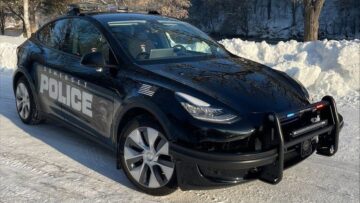This article is part of a short series. You can find Part 1 here, Part 2 here, and Part 3 here.
How Far We’ve Come
While electric cars were once dominant (around 1900), they fell from use because the battery technology of the time just wasn’t really up to most drivers’ needs. Once Cadillac started putting electric starters on their cars, the worst of what gas-powered cars had to offer was mitigated, and EVs just didn’t compete for over 100 years.
In 1955, photovoltaic cells were a joke. Serious work was happening to make them not be a joke, and had been going for decades. It wasn’t until the year before that they appeared to have any hint of being viable.
When GM’s William Cobb built an experimental toy solar car in 1955 for an auto show, he didn’t know what would ultimately come of it. Obviously, he hoped it would do something good, but he had no way to know that roughly 30 years later, people inspired by his little project would make a vehicle that could cross a continent. He had no idea that people would end up racing solar-powered cars, and that a winning car would lead to a two-staged revolution in the market.
The Situations That Birthed The Modern EVs’ Great-Grandparents
There’s one other thing we need to discuss if we want to understand the roots of modern EVs. The first step toward the EV comeback wasn’t actually battery technology at all. It was efficiency.
Prior to the 1970s, there just wasn’t a perceived need for efficient vehicles. Gasoline was cheap, and most people had no idea that they were hurting anything. Especially in the United States, having a big, blocky, gas-guzzling vehicle just wasn’t a problem for most people. Even as things changed, it really took some big knocks to get people out of that rut.
Oil crises in 1973 and 1979 changed minds, though. Sure, many people even today don’t want to change their ways, but those crises tipped the market just enough to where there was a much larger market for efficient vehicles that used less fuel. American automakers struggled to change their ways, and this led to the “Malaise Era” of automobiles as they gained footing.
Once they did finally start to get their stride (fuel injection was a big contributor to this), that’s when experiments like the Fiero, the Sunraycer, the Impact, and the EV1 came to be. American companies struggled, but that struggle did lead to better companies that were able to innovate again.
In many ways, the end of this first modern era of EVs (marked by the death of the EV1) was what I’d call the Second Malaise Era. The cars weren’t complete rusty garbage like many late ’70s American cars, but American manufacturers got complacent. Front-wheel-drive crossovers took much of the market over while the largest and most inefficient SUVs became the luxury cars Americans yearned for.
It took the 2008 financial crisis for Americans and people in many other markets to come to their senses. Efficiency came back, and EVs started to emerge again without strict government mandates.
Solar Is About To Hit Its Stride
The modern EV era launched on the backs of solar cars, with manufacturers turning to non-solar EVs when they saw that onboard solar just wasn’t economical. But, that’s in the process of changing.
The solar cells that we take for granted today are now around 20% efficiency. That means that 20% of the solar energy that strikes them becomes electricity, while the rest doesn’t. Back in the 1980s, the best experimental and expensive solar cells were around 20%, but today’s best cells on the market exceed 24%. What was once wildly experimental is now the norm in a much larger market.
Even now, every time I write an article about a company like Aptera or Sono Motors, a number of readers want to tell us how it will never work. Putting solar panels could never produce enough energy to make a meaningful contribution to the car’s propulsion. The idea that a vehicle could be a “never charge electric vehicle” is just not something many people think will ever happen.
But, like the solar cars of the 1980s, what’s possible can quickly surprise people who don’t follow the technology. Aptera’s super efficient design can add 40 miles of range to the vehicle daily just by parking in the sun. Sono claims that their solar panels can add 70 miles per week. Those aren’t amazing figures, but they’re enough to cover most people’s daily driving, and even give “rollover miles” in the battery pack.
We’re at the point where solar cars for the general market are about to become reality. Just as battery technology allowed the EV revolution to really take hold in the last decade, solar technology is doing the same.
Where We’re Going: Expect A Bumpy Ride Here and There
Seeing where we came from can also tell us a lot about where we’re going.
It’s tempting to think that the EV revolution will be a nice and easy climb from here in 2021 to 2030 and 2040. Things are looking good for EVs right now, but they looked like they were doing great in 1999. We’re very unlikely to see EVs basically go away again in the next few years, but it’s foolish to think that there will be no setbacks along the way.
I don’t claim to know what those setbacks will be, but I do have a few guesses.
One possible issue coming up will be shaky government support for EVs. EVs are a lot more entrenched then they were in 1999, so that won’t kill them off, but the adoption rate could suffer as governments waver in their commitment to them.
Battery supplies could also become an issue. It’s very possible to make enough cells for everybody, but manufacturers who aren’t forward-looking enough to secure their supplies today might find themselves without enough supply to sell enough EVs. Once again, this will only slow the transition down and not stop it. It could also lead a continued “electrification” of fleets and not actual EV adoption. While hybrids and plug-in hybrids are better than straight gas, they could put the brakes on a larger adoption of full EVs.
Whatever the pitfalls are, we need to be smart and not let them frighten us into giving up.
Appreciate CleanTechnica’s originality? Consider becoming a CleanTechnica Member, Supporter, Technician, or Ambassador — or a patron on Patreon.

- 100
- 2021
- Adoption
- Advertise
- All
- American
- Americans
- around
- article
- auto
- automakers
- battery
- BEST
- Cadillac
- call
- car
- cars
- change
- charge
- claims
- cleantech
- Cleantech Talk
- coming
- Companies
- company
- crisis
- Design
- DID
- driving
- efficiency
- Electric
- electric vehicles
- electricity
- energy
- EV
- Finally
- financial
- financial crisis
- First
- follow
- Fuel
- full
- GAS
- General
- Giving
- good
- Government
- Governments
- great
- Guest
- here
- hold
- How
- HTTPS
- idea
- Impact
- IT
- lead
- Led
- looked
- Market
- Markets
- offer
- Other
- parking
- Patreon
- People
- podcast
- project
- racing
- range
- readers
- Reality
- REST
- sell
- Series
- Setbacks
- Short
- smart
- So
- solar
- solar energy
- solar panels
- solar-powered
- start
- started
- starters
- States
- stride
- Strikes
- supply
- support
- surprise
- SUVs
- Technology
- time
- toy
- United
- United States
- us
- vehicle
- Vehicles
- week
- WHO
- Wikipedia
- Work
- year
- years











